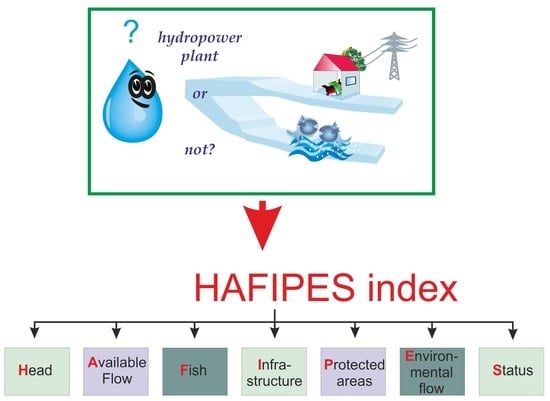Possibility of Hydropower Development: A Simple-to-Use Index
Abstract
1. Introduction
2. Materials and Literature Overview
3. Proposed Method—An Innovative System
3.1. Characteristics of the System
3.2. The Name of the System
3.3. Computation Formula of the HAFIPES Index
3.4. Characteristics of the Factors
- Theoretically, every river cross-section has hydropower potential;
- Technically, construction of a hydropower plant is possible in every river section;
- The economic evaluation of hydropower project implementation is carried out on a case-by-case basis and depends on the financial circumstances of the investor (own free financial resources, creditworthiness, etc.); therefore, it is not included in the HAFIPES system. It should be supplementary, independent, and based on individual input data of a specific investor; political conditions vary from country to country. This could also affect the possibility. In my opinion, based on experience, the political conditions cannot be implemented in the HAFIPES system in a simple way. It is important to remember that the proposed system is presented as a simple and easy-to-use model. This method is new, unknown as of yet, and to be further developed in the future. At the moment, this methodology is based on expert opinion, experience, and knowledge.
- No limit range has been set for H and A factors. For each subsequent step (equal to 0.5 m for H and 0.5 m3/s with reference to A), the next rank value is assigned.
- For the need to preserve the EF, a correction was made in the formula (1) by subtracting the value valid for passing the unproductive EF from the value A = MF for the cross-section of the watercourse, i.e.,A = MF − EF
- For factor F, two possible values are set: “1” for a watercourse not designated as significant for diadromous fish and “0” for water organisms important for migration. The value “0” is included in Formula (1) not as a separate factor, but among the group of factors, and thus the assignment of the value “0” to it does not disqualify a location from the implementation of SHPP,
- For factor I, three possible values are set: “0” for the lack of infrastructure, “1” for the existence of historical infrastructure obligatory to be reconstructed, and “2” for the existing infrastructure that can be adapted without significant financial outlays for construction works. Similarly as for factor F, the value of “0” has been included in Formula (1), not as a separate factor, but among a group of factors, and thus the assignment of the value “0” to it does not disqualify a location from the implementation of SHPP,
- For factor P, the value “0” is assigned to strict protection areas (wildlife nature reservations or other, for which the implementation of SHPP means collision with conservation objectives). In this case, this factor was isolated in Formula (1), and giving it a value of “0” makes the estimation of the possibility of realizing the SHPP impossible (P = 0 → EP = 0). The remaining protected areas have rankings with the increase in their level of protection, and thus the potential prohibitions on the implementation of new investments. This means that recognizing the status and possible collision is necessary for the correct assessment of the value of the factor. In different countries, the system of protecting nature (especially wildlife nature reserve) might be different, but the proposed ranking factors seem to be the most universal. The final decision depends on the researcher who could assess the value of the factor based on their own recognition of the status of the analyzed protected area,
- For factor S, two values are set: “0” when the status according to WFD based on hydromorphological criteria is deemed bad and “1” when it is deemed good. It is extremely important to remember that in the case of a good SWB status as well, the proposed investment cannot affect the loss of this status. The value of the factor equal to “0” means that another investment that deepens the hydromorphological continuity of the watercourse will make it difficult to achieve environmental objectives for SWB and thus it will not be implemented (a decision on the environmental conditions of consent for the investment will not be granted). This factor was introduced as a separate one in the formula (1), where for the zero value, the possibility of SHPP realization is equal to zero (S = 0, EP = 0).
3.5. SHPP Implementation Possibility Categories
4. Main Criteria Used in the HAFIPES System: The Actual Possibilities and Risks
4.1. Location within an Area of Strict Protection of Nature
4.2. Status Based on Hydromorphological Criteria
4.3. Variable Condition of Hydrotechnical Infrastructures
4.4. Environmental Flow
5. Case Studies
6. Discussion
7. Conclusions
Funding
Institutional Review Board Statement
Informed Consent Statement
Conflicts of Interest
Abbreviations
| HPP | Hydropower plant |
| SHPP | Small hydropower plant |
| WFD | Water Framework Directive |
| SWB | Surface water body |
| EU | European Union |
| RE | Renewable energy |
| RES | Renewable energy sources |
| GIS | Geographics information system |
| TP | theoretical potential [kWh] |
| TCHP | technical potential [kWh] |
| EP | effective potential [kWh] |
| MF | mean flow [m3/s] |
| MLF | mean low flow [m3/s] |
| H | head [m] |
| A | available flow [m3/s] |
| EF | environmental flow [m3/s] |
References
- Li, X.-Z.; Chen, Z.-J.; Fan, X.-C.; Cheng, Z.-J. Hydropower development situation and prospects in China. Renew. Sustain. Energy Rev. 2018, 82, 232–239. [Google Scholar] [CrossRef]
- Morales, S.; Álvarez, C.; Acevedo, C.; Diaz, C.; Rodriguez, M.; Pacheco, L. An overview of small hydropower plants in Colombia: Status, potential, barriers and perspectives. Renew. Sustain. Energy Rev. 2015, 50, 1650–1657. [Google Scholar] [CrossRef]
- Năstase, G.; Șerban, A.; Dragomir, G.; Brezeanu, A.I.; Bucur, I. Photovoltaic development in Romania. Reviewing what has been done. Renew. Sustain. Energy Rev. 2018, 94, 523–535. [Google Scholar] [CrossRef]
- Sample, J.E.; Duncan, N.; Ferguson, M.; Cooksley, S. Scotland’s hydropower: Current capacity, future potential and the possible impacts of climate change. Renew. Sustain. Energy Rev. 2015, 52, 111–122. [Google Scholar] [CrossRef]
- Sharma, S.; Waldman, J.; Afshari, S.; Fekete, B. Status, trends and significance of American hydropower in the changing energy landscape. Renew. Sustain. Energy Rev. 2019, 101, 112–122. [Google Scholar] [CrossRef]
- Ferreira, J.H.I.; Camacho, J.R.; Malagoli, J.A.; Júnior, S.C.G. Assessment of the potential of small hydropower development in Brazil. Renew. Sustain. Energy Rev. 2016, 56, 380–387. [Google Scholar] [CrossRef]
- Operacz, A. The term “effective hydropower potential” based on sustainable development—An initial case study of the Raba river in Poland. Renew. Sustain. Energy Rev. 2017, 75, 1453–1463. [Google Scholar] [CrossRef]
- Llamosas, C.; Sovacool, B.K. The future of hydropower? A systematic review of the drivers, benefits and governance dynamics of transboundary dams. Renew. Sustain. Energy Rev. 2021, 137, 110495. [Google Scholar] [CrossRef]
- Creţan, R.; Vesalon, L. The Political Economy of Hydropower in the Communist Space: Iron Gates Revisited. Tijdschr. Voor Econ. Soc. Geogr. 2017, 108, 688–701. [Google Scholar] [CrossRef]
- Perry, D.; Harrison, I.; Fernandes, S.; Burnham, S.; Nichols, A. Global Analysis of Durable Policies for Free-Flowing River Protections. Sustainability 2021, 13, 2347. [Google Scholar] [CrossRef]
- Sritram, P.; Suntivarakorn, R. Comparative Study of Small Hydropower Turbine Efficiency at Low Head Water. Energy Procedia 2017, 138, 646–650. [Google Scholar] [CrossRef]
- Boys, C.A.; Pflugrath, B.D.; Mueller, M.; Pander, J.; Deng, Z.D.; Geist, J. Physical and hydraulic forces experienced by fish passing through three different low-head hydropower turbines. Mar. Freshw. Res. 2018, 69, 1934. [Google Scholar] [CrossRef]
- Yang, W.; Norrlund, P.; Bladh, J.; Yang, J.; Lundin, U. Hydraulic damping mechanism of low frequency oscillations in power systems: Quantitative analysis using a nonlinear model of hydropower plants. Appl. Energy 2018, 212, 1138–1152. [Google Scholar] [CrossRef]
- Chazarra, M.; Perez-Diaz, J.I.; Garcia-Gonzalez, J. Optimal Joint Energy and Secondary Regulation Reserve Hourly Scheduling of Variable Speed Pumped Storage Hydropower Plants. IEEE Trans. Power Syst. 2018, 33, 103–115. [Google Scholar] [CrossRef]
- Operacz, A.; Wałęga, A.; Cupak, A.; Tomaszewska, B. The comparison of environmental flow assessment—The barrier for investment in Poland or river protection? J. Clean. Prod. 2018, 193, 575–592. [Google Scholar] [CrossRef]
- Operacz, A.; Tomaszewska, B. The review of Polish formal and legal aspects related to hydropower plants. Environ. Sci. Pollut. Res. 2016, 23, 18953–18959. [Google Scholar] [CrossRef] [PubMed]
- Operacz, A.; Grahl-Madsen, M. Program of hydropower potential assessment as an effective possibilities in upper vistula water region in poland. Acta Sci. Pol. Form. Circumiectus 2018, 4, 157–172. [Google Scholar] [CrossRef]
- Operacz, A.; Kotowski, T.; Bugajski, P. Hydropower potential of the Mszanka river in the south Poland—The course of estima-tion. Environ. Probl. 2018, 3, 193–202. [Google Scholar]
- Allwood, J.M.; Bosetti, V.; Dubash, N.K.; Gómez-Echeverri, L.; von Stechow, C. Glossary. In Climate Change 2014: Mitigation of Climate Change. Contribution of Working Group III to the Fifth Assessment Report of the Intergovernmental Panel on Cli-mate Change; Edenhofer, O., Pichs-Madruga, R., Sokona, Y., Farahani, E., Kadner, S., Seyboth, K., Adler, A., Baum, I., Brunner, S., Eickemeier, P., et al., Eds.; Cambridge University Press: Cambridge, UK; New York, NY, USA, 2014. [Google Scholar]
- Stangeland, A.; Grini, G. The Potential and Barriers for Renewable Energy; Bellona Paper: Oslo, Norway, 2007. [Google Scholar]
- Hoogwijk, M.; Graus, W. Global Potential of Renewable Energy Sources: A Literature Assessment; Background report prepared by order of REN21; Ecofys, PECSNL072975; Ecofys: Utrecht, NL, 2008. [Google Scholar]
- Krewitt, W.; Simon, S.; Pregger, T. Renewable Energy Deployment Potentials in Large Economies; DLR (German Aerospace Center): Cologne, Germany, 2008. [Google Scholar]
- Resch, G.; Held, A.; Faber, T.; Panzer, C.; Toro, F.; Haas, R. Potentials and prospects for renewable energies at global scale. Energy Policy 2008, 36, 4048–4056. [Google Scholar] [CrossRef]
- Kuriqi, A.; Pinheiro, A.N.; Sordo-Ward, A.; Bejarano, M.D.; Garrote, L. Ecological impacts of run-of-river hydropower plants—Current status and future prospects on the brink of energy transition. Renew. Sustain. Energy Rev. 2021, 142, 110833. [Google Scholar] [CrossRef]
- Kuriqi, A.; Pinheiro, A.N.; Sordo-Ward, A.; Garrote, L. Water-energy-ecosystem nexus: Balancing competing interests at a run-of-river hydropower plant coupling a hydrologic–ecohydraulic approach. Energy Convers. Manag. 2020, 223, 113267. [Google Scholar] [CrossRef]
- Act of 3 October 2008 on Provision of Information about the Environment and Its Protection, Public Participation in Environmental Protection and Environmental Impact Assessments (consolidated text in Dz.U.2018 poz. 2081). Available online: https://ippc.mos.gov.pl/ippc/custom/ustawa_o_dostepie_do_informacji_o_srodowisku_English(1).pdf (accessed on 8 April 2020).
- Announcement of the Prime Minister of 21 December 2015 Regarding the Publication of the Consolidated Text of the Regula-tion of the Council of Ministers Regarding Undertakings That May Significantly Affect the Environment (Dz. U. 2016 poz. 71). Available online: http://isap.sejm.gov.pl/isap.nsf/download.xsp/WDU20160000071/O/D20160071.pdf (accessed on 8 April 2020).
- International Finance Corporation. Hydroelectric Power: A Guide for Developers and Investors; World Bank Group: Washington, DC, USA, 2015; p. 120. [Google Scholar]
- Bernhard Pelikan. Guide on How to Develop a Small Hydropower Plant; European Small Hydropower Association: Brussels, Belgium, 2004; p. 296. [Google Scholar]
- Stefano Mara, Giuseppe Stella. D5.2 Manual Addressed to Stakeholders with the Description of Methodologies to Improve SHP Implementation in See Countries Work Package 5-COM-MON Strategies to Improve SHP Implementation; SEE Hydropower; Brill: Leiden, The Netherlands, 2010; p. 90. Available online: http://www.seehydropower.eu/download_tools/files/2/VAPIDRO_ASTE-4.0_user_guide_customized_SEE_HYDROPOWER.pdf (accessed on 8 April 2020).
- Hartmann, J.; Harrison, D.; Gill, R.; Opperman, J. The Next Frontier of Hydropower Sustainability: Planning at the System Scale. 2013. Available online: https://www.conservationgateway.org/ConservationPractices/Freshwater/WaterInfrastructure/Pages/hydroatscale.aspx (accessed on 8 April 2020).
- International Hydropower Association Sustainability. Available online: https://www.hydrosustainability.org/ihasustainability (accessed on 9 July 2020).
- Hydropower Sustainability Assessment Protocol. Available online: https://www.hydrosustainability.org/assessment-protocol (accessed on 9 July 2020).
- Kucukali, S.; Baris, K. Assessment of small hydropower (SHP) development in Turkey: Laws, regulations and EU policy perspective. Energy Policy 2009, 37, 3872–3879. [Google Scholar] [CrossRef]
- Evans, A.; Strezov, V.; Evans, T.J. Assessment of sustainability indicators for renewable energy technologies. Renew. Sustain. Energy Rev. 2009, 13, 1082–1088. [Google Scholar] [CrossRef]
- Mondal, A.H.; Denich, M. Assessment of renewable energy resources potential for electricity generation in Bangladesh. Renew. Sustain. Energy Rev. 2010, 14, 2401–2413. [Google Scholar] [CrossRef]
- Manders, T.M.; Hoofken, J.I.; van der Vleuten, E.B.A. Small-scale hydropower in the Netherlands: Problems and strategies of system builders. Renew Sustain. Energy Rev. 2016, 59, 1493–1503. [Google Scholar] [CrossRef]
- Aller, L.; Bennett, T.; Lehr, J.H.; Petty, R.J. DRASTIC—A Standardized System for Evaluating Ground Water Pollution Potential Using Hydrogeologic Settings; EPA/600/2–85/018; U.S. Environmental Protection Agency: Washington, DC, USA, 1985. [Google Scholar]
- Al-Adamat, R.; Foster, I.; Baban, S. Groundwater vulnerability and risk mapping for the Basaltic aquifer of the Azraq basin of Jordan using GIS, Remote sensing and DRASTIC. Appl. Geogr. 2003, 23, 303–324. [Google Scholar] [CrossRef]
- Al-Zabet, T. Evaluation of aquifer vulnerability to contamination potential using the DRASTIC method. Environ. Earth Sci. 2002, 43, 203–208. [Google Scholar] [CrossRef]
- Baalousha, H. Vulnerability assessment for the Gaza Strip, Palestine using DRASTIC. Environ. Earth Sci. 2006, 50, 405–414. [Google Scholar] [CrossRef]
- Babiker, I.S.; Mohamed, M.A.; Hiyama, T.; Kato, K. A GIS-based DRASTIC model for assessing aquifer vulnerability in Kakamigahara Heights, Gifu Prefecture, central Japan. Sci. Total. Environ. 2005, 345, 127–140. [Google Scholar] [CrossRef]
- Krajewski, I. Metoda oceny zagrożenia jakości wód podziemnych za pomocą systemu DRASTIC. Zesz. Nauk. AR Wrocławiu Ser. Inżynieria Sr. 2000, 385, 217–223. [Google Scholar]
- Kumar, S.; Thirumalaivasan, D.; Radhakrishnan, N. GIS Based Assessment of Groundwater Vulnerability Using Drastic Model. Arab. J. Sci. Eng. 2014, 39, 207–216. [Google Scholar] [CrossRef]
- Lee, S. Evaluation of waste disposal site using the DRASTIC system in Southern Korea. Environ. Earth Sci. 2003, 44, 654–664. [Google Scholar] [CrossRef]
- Kim, Y.J.; Hamm, S. Assessment of the potential for groundwater contamination using the DRASTIC/EGIS technique, Cheongju area, South Korea. Hydrogeol. J. 1999, 7, 227–235. [Google Scholar] [CrossRef]
- Wang, Y.; Merkel, B.J.; Li, Y.; Ye, H.; Fu, S.; Ihm, D. Vulnerability of groundwater in Quaternary aquifers to organic contaminants: A case study in Wuhan City, China. Environ. Earth Sci. 2007, 53, 479–484. [Google Scholar] [CrossRef]
- Alwathaf, Y.; El Mansouri, B. Assessment of Aquifer Vulnerability Based on GIS and ARCGIS Methods: A Case Study of the Sana’a Basin (Yemen). J. Water Resour. Prot. 2011, 3, 845–855. [Google Scholar] [CrossRef][Green Version]
- Resolution no 4/2014 of the Regional Water Management Authority (RZGW) Director in Krakow from 16 January 2014 r. on the Conditions of Use of the Waters of the Upper Vistula Water Region. Available online: http://www.krakow.rzgw.gov.pl (accessed on 15 February 2016).
- Water Management Plan for the Vistula River Basin. Monitor Polski no 49, Position 549. 2011. Available online: http://g.ekspert.infor.pl/p/_dane/akty_pdf/MPO/2011/49/549.pdf#zoom=90 (accessed on 8 April 2020).
- Młyński, D.; Kurek, K.; Bugajski, P. An Analysis of Seasonal Waste Draining for the Urban Agglomeration Using Statistical Methods. Water 2018, 10, 976. [Google Scholar] [CrossRef]
- Chmielowski, K.; Bugajski, P.; Kaczor, G.B. Comparative analysis of the quality of sewage discharged from selected agglomeration sewerage systems. J. Water Land Dev. 2016, 30, 35–42. [Google Scholar] [CrossRef]
- Wiatkowski, M.; Tomczyk, P. Comparative Assessment of the Hydromorphological Status of the Rivers Odra, Bystrzyca, and Ślęza Using the RHS, LAWA, QBR, and HEM Methods above and below the Hydropower Plants. Water 2018, 10, 855. [Google Scholar] [CrossRef]
- Kowalczyk-Juśko, A.; Mazur, A.; Grzywna, A.; Listosz, A.; Rybicki, R.; Pytka, A.; Dorozhynskyy, O.; Jóźwiakowski, K.; Gizińska-Górna, M. Evaluation of the possibilities of using water-damming devices on the Tyśmienica River to build small hydropower plants. J. Water Land Dev. 2017, 35, 113–119. [Google Scholar] [CrossRef][Green Version]
- Poff, N.L.; Zimmerman, J.K.H. Ecological responses to altered flow regimes: A literature review to inform the science and management of environmental flows. Freshw. Biol. 2010, 55, 194–205. [Google Scholar] [CrossRef]
- Arthington, A.H. The challenge of providing environmental flow rules to sustain river ecosystems. Ecol. Appl. 2006, 16, 1311–1318. [Google Scholar] [CrossRef]
- Zingraff-Hamed, A.; Noack, M.; Greulich, S.; Schwarzwälder, K.; Pauleit, S.; Wantzen, K.M. Model-Based Evaluation of the Effects of River Discharge Modulations on Physical Fish Habitat Quality. Water 2018, 10, 374. [Google Scholar] [CrossRef]
- Declaration, T.B. The Brisbane declaration: Environmental flows are essential for freshwater ecosystem health and human well-being. In Proceedings of the Declaration of the 10th International River Symposium, Brisbane, Australia, 3–6 September 2007. [Google Scholar]
- O’Keeffe, J.; Quesne, T. Keeping rivers alive: A primer on environmental flows. WWF Water Secur. Ser. 2009, 2, 39. [Google Scholar]
- Efstratiadis, A.; Tegos, A.; Varveris, A.; Koutsoyiannis, D. Assessment of environmental flows under limited data availability: Case study of the Acheloos River, Greece. Hydrol. Sci. J. 2014, 59, 731–750. [Google Scholar] [CrossRef]
- Dyson, M.; Bergkamp, G.; Scanlon, J. Flow: The Essentials of Environmental Flows; Dyson, M., Bergkamp, G.J.J., Scanlon, J., Eds.; International Union for Conservation of Nature and Natural Resources (IUCN): Gland, Switzerland; Cambridge, UK, 2003. [Google Scholar]
- Młyński, D.; Wałęga, A.; Wachulec, K. Comparison of Methods for Determining Environmental Flow in Selected Mountain Basins. Inżynieria Ekol. 2015, 44, 184–190. [Google Scholar] [CrossRef]
- Water Law Dated 20 July 2017 Published in the Polish Journal of Laws (Dz.U. 2017 poz. 1556) with Additional Changes. Available online: http://isap.sejm.gov.pl/isap.nsf/download.xsp/WDU20170001556/O/D20171556.pdf (accessed on 8 April 2020).
- Operacz, A. Estimating the value of inviolable flow in surface water investments according to Kostrzewa method. Econ. Environ. 2015, 52, 100–109. [Google Scholar]
- Bergel, T.; Pawełek, J. Efficient consumption of tap water as a determinant of the protection of water resources. Pol. J. Environ. Stud. 2007, 16, 26–29. [Google Scholar]
- Operacz, A.; Tomaszewska, B.; Wojanowska, J. Small hydro power plants working on technological waters—The review of formal and legal aspects. Geol. Explor. Technol. Geotherm. Sustain. Dev. 2014, 2, 19–27. [Google Scholar]
- Książek, L.; Woś, A.; Florek, J.; Wyrębek, M.; Młyński, D.; Wałęga, A. Combined use of the hydraulic and hydrological methods to calculate the environmental flow: Wisloka river, Poland: Case study. Environ. Monit. Assess. 2019, 191, 1–17. [Google Scholar] [CrossRef]
- Młyński, D.; Wałęga, A.; Petroselli, A.; Tauro, F.; Cebulska, M. Estimating Maximum Daily Precipitation in the Upper Vistula Basin, Poland. Atmosphere 2019, 10, 43. [Google Scholar] [CrossRef]
- Młyński, D.; Wałęga, A.; Cebulska, M. Trends, variability, and seasonality of maximum annual daily precipitation in the up-per Vistula basin, Poland. Atmosphere 2018, 9, 313. [Google Scholar] [CrossRef]
- Młyński, D.; Wałęga, A.; Stachura, T.; Kaczor, G. A New Empirical Approach to Calculating Flood Frequency in Ungauged Catchments: A Case Study of the Upper Vistula Basin, Poland. Water 2019, 11, 601. [Google Scholar] [CrossRef]
- Wałęga, A.; Młyński, D. Seasonality of median monthly discharge in selected Carpathian rivers of the upper Vistula basin. Carpath. J. Earth Environ. Sci. 2017, 12, 617–628. [Google Scholar]
- Okedu, K.E.; Uhunmwangho, R.; Odje, M. Harnessing the potential of small hydro power in Cross River state of Southern Nigeria. Sustain. Energy Technol. Assess. 2020, 37, 100617. [Google Scholar] [CrossRef]

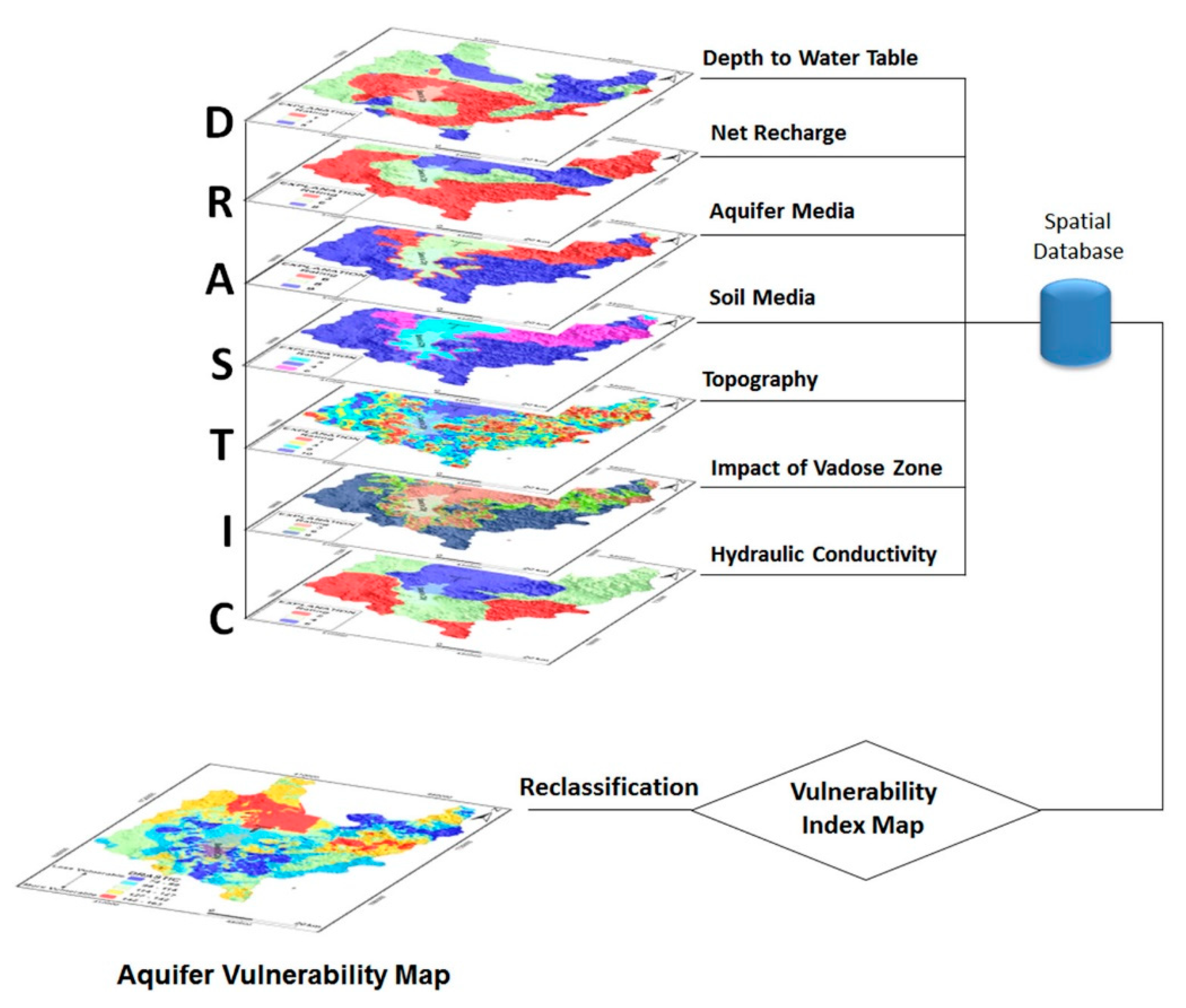

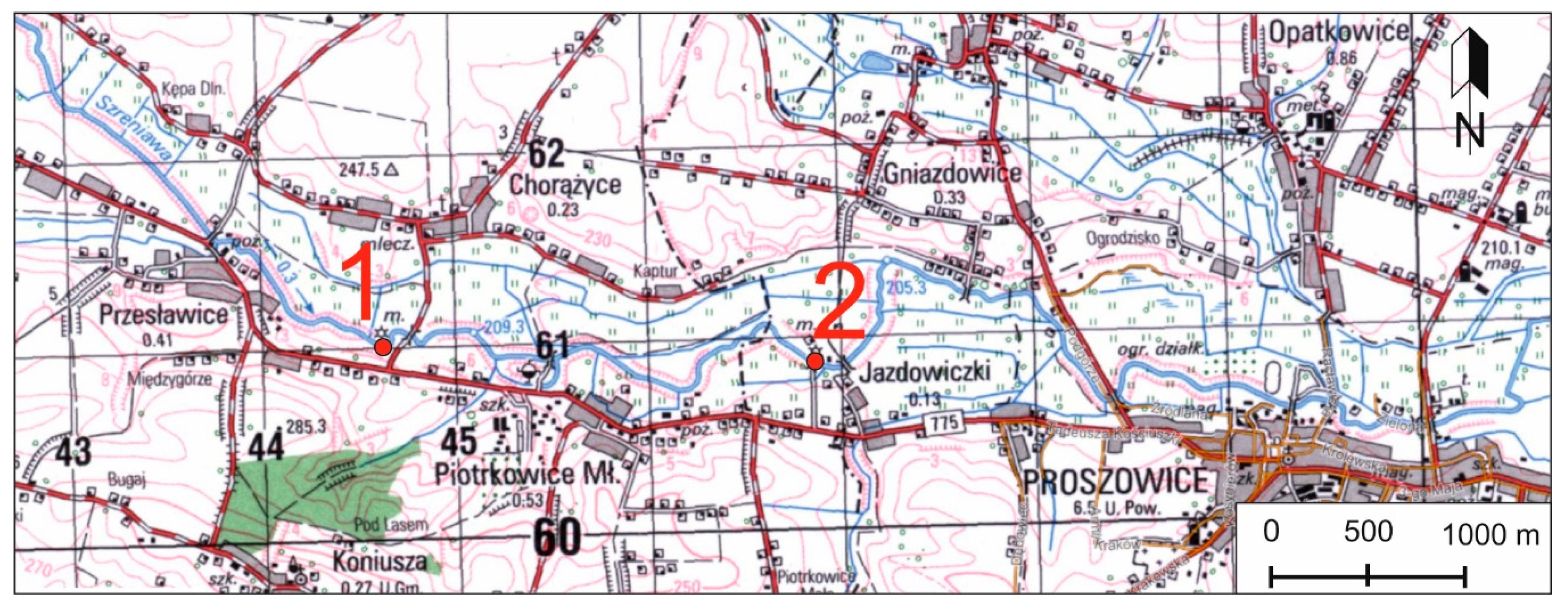
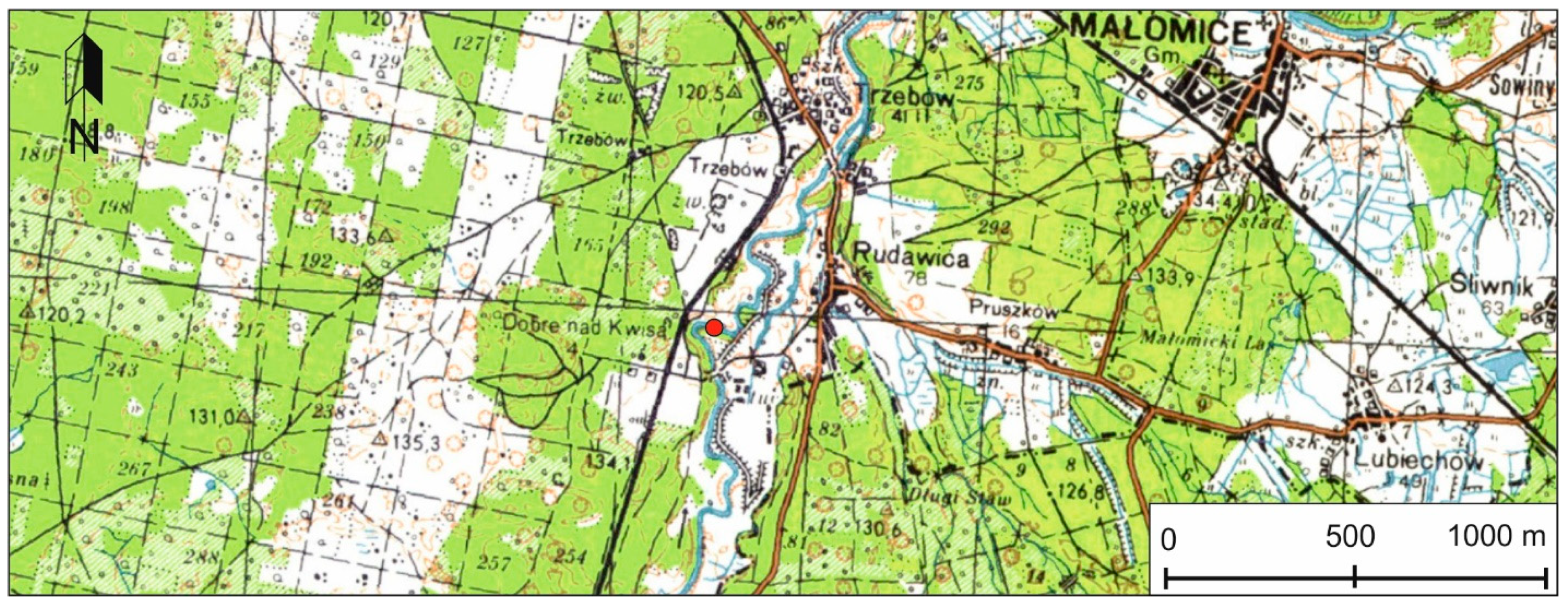
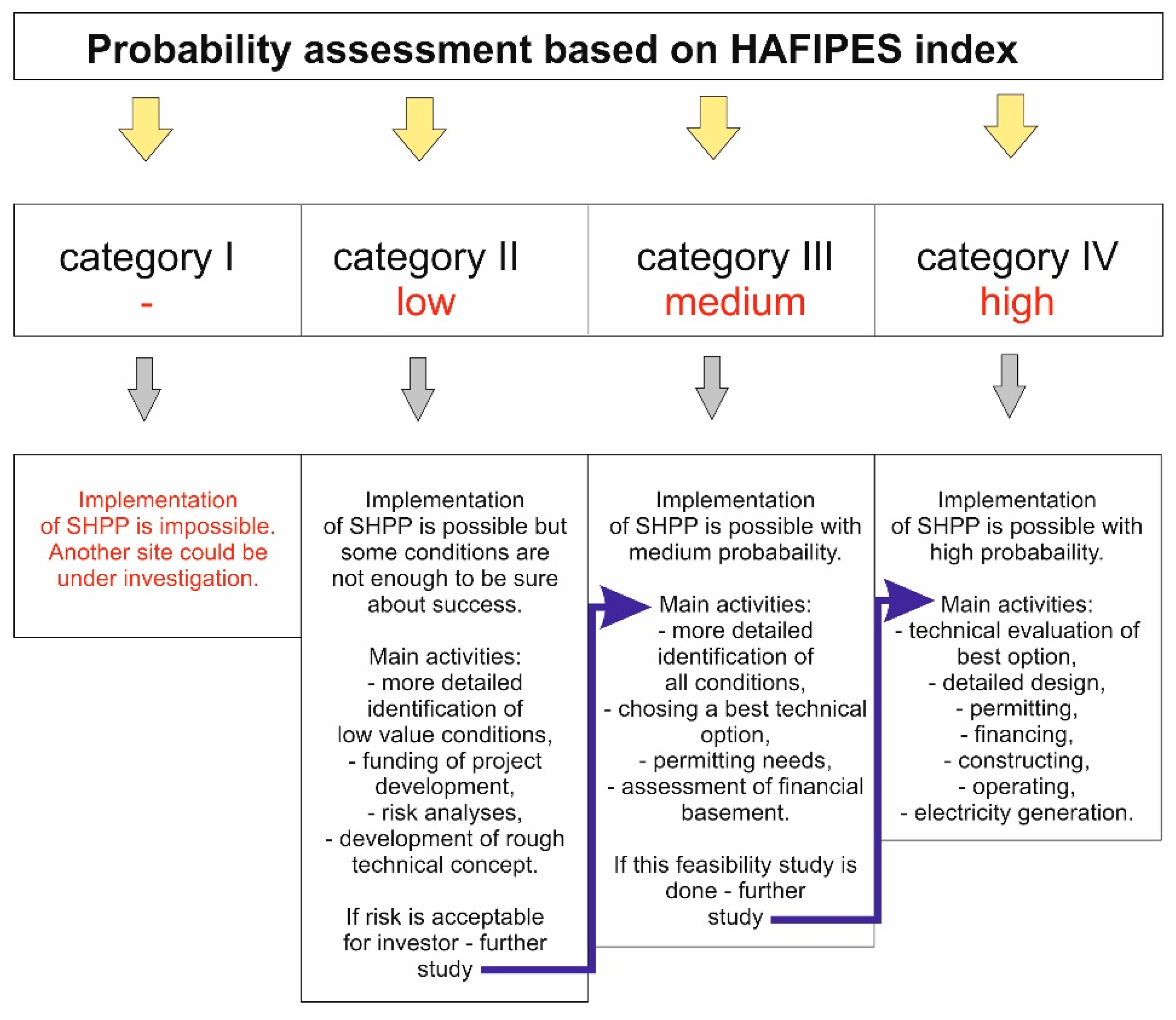
| Author(s) | Definitions |
|---|---|
| Stangeland [20] | Realistic potential: the amount of energy that can realistically be utilized after marked barriers and other barriers such as social acceptance, environmental factors, and area conflicts have been taken into account. Realizable potential: the energy that can be realized within a given timeframe. This energy potential depends on economic conditions as well as global market production capacity. |
| Hoogwijk and Graus [21] | Market potential: the market potential is the total amount of RE that can be implemented in the market, taking into account the demand for energy, the competing technologies, the costs and subsidies of RES, and the barriers. As opportunities are also included, the market potential may in theory be larger than the economic potential; however, the market potential is lower because of all kinds of barriers. |
| Krewitt et al. [22] | Deployment potential: characterizes the potential market uptake of RE technologies under pre-defined framing conditions. It depends on, e.g., the structure of the existing supply system, the development of energy demand, and energy policy targets and instruments in place. Demand potential: with the increasing competitiveness of REs, in the future, the economic potential may exceed the energy demand. In such a case, the deployment potential of RES will of course be limited by the energy demand. |
| Resch et al. [23] | Realizable potential: represents the maximal achievable potential assuming that all existing barriers can be overcome and all driving forces are active. Thus, general parameters, such as market growth rates and planning constraints, are taken into account. It is important to mention that this potential term must be seen in a dynamic context, i.e., the realizable potential has to refer to a certain year. Mid-term potential: the mid-term potential is equal to the realizable potential for the year 2020. |
| Operacz [7] | Effective potential: the actual river potential that may be achieved in a short time under conditions of the existing legal regulations. It does not take into account the economic analyses (individual and energy market). It is determined based on the real current application of procedures and significant limitations (the environmental situation as well as existing and manageable hydrotechnical infrastructure). |
| Factor | Numerical Factor | Weight Factor |
|---|---|---|
| H (Head) | in 1 steps with change of 0.5 m i.e., 0.00 m < H < 0.5 m → “0” 0.51 m < H < 1.0 m → “1” 1.01 m < H < 1.5 m → “2”, etc. | 2 |
| A (Available Flow) | in 1 steps with change of 0.5 m3/s i.e., 0.01 m3/s < MF < 0.5 m3/s → “1” 0.51 m3/s < MF < 1.0 m3/s → “2” 1.01 m3/s < MF < 1.5 m3/s → “3”, etc. If EF is taken into account, the final value is similarly calculated acc. A = MF-EF (2) | 2 |
| F (Fish) | F = 1—watercourse not significant for diadromous fish F = 0—watercourse significant for diadromous fish | 1 |
| I (Infrastructure) | I = 0 with no infrastructure I = 1 for historical infrastructure to be reconstructed I = 2 for existing operational infrastructure | 3 |
| P (Protected Areas) | P = 0 for wildlife nature reservations and areas of strict protection as well as others whose protection objectives are directly in conflict with the SHPP implementation P = 1 for national parks P = 2 for Natura 2000 areas and landscape parks P = 3 for protected landscape areas and ecological lands P = 5 for areas not covered by any form of nature protection | - |
| E (Environmental Flow) | added to the formula for A | 2—along with A |
| S (Status) | S = 0, when the SWB status according to WFD based on hydromorphological criteria is deemed bad S = 1, when the SWB status according to WFD based on hydromorphological criteria is deemed good | - |
| Index HAFIPES | Possibility Category | Possibility Explanations |
|---|---|---|
| 0 | I | SHPP implementation impossible |
| 1–25 | II | low possibility of SHPP implementation |
| 26–50 | III | medium possibility of SHPP implementation |
| >50 | IV | high possibility of SHPP implementation |
| Factor | Weight Factor | Name of Location | ||
|---|---|---|---|---|
| Jazdowiczki on Szreniawa River | Jaksice on Szreniawa River | Rudawica on Kwisa River | ||
| H (Head) | 2 | head = 2.0 m → H = 3 | head potential = 1.0 m → H = 1 | head potential = 3.0 m → H = 5 |
| A (Available Flow) | 2 | MF = 1.5 m3/s; MLF = 0.7 m3/s EF as 50% of MLF [51] A = MF-EF = 1.5–0.35 m3/s → A = 3 | MF = 1.5 m3/s; MLF = 0.7 m3/s E as 50% of MLF [51] A = MF-EF = 1.5–0.35 m3/s → A = 3 | MF = 13.0 m3/s; MLF = 6.7 m3/s EF as 50% of MLF [51] thus A = MF-EF = 13.0–3.35 m3/s → A = 20 |
| F (Fish) | 1 | F = 1—watercourse not significant for diadromous fish | F = 1—watercourse not significant for diadromous fish | F = 1—watercourse not significant for diadromous fish |
| I (Infrastructure) | 3 | I = 2 for full existing infrastructure | I = 1 for historical infrastructure to be reconstructed | I = 1 for historical infrastructure to be reconstructed |
| P (Protected Areas) | - | P = 3 for the Miechowska Upland Protected Landscape | P = 3 for the Miechowska Upland Protected Landscape | P = 0 for the Bory Dolnośląskie Protected Landscape |
| E (Environmental Flow) | 2—along with A | added to the formula for A | added to the formula for A | added to the formula for A |
| S (Status) | - | S = 1, the SWB defined as good | S = 1, the SWB defined as good | S = 1, the SWB status defined as good |
| HAFIPES index | 57 | 36 | 0 | |
| Possibility category acc. Table 3 | IV (high) | III (medium) | I (impossible) | |
Publisher’s Note: MDPI stays neutral with regard to jurisdictional claims in published maps and institutional affiliations. |
© 2021 by the author. Licensee MDPI, Basel, Switzerland. This article is an open access article distributed under the terms and conditions of the Creative Commons Attribution (CC BY) license (https://creativecommons.org/licenses/by/4.0/).
Share and Cite
Operacz, A. Possibility of Hydropower Development: A Simple-to-Use Index. Energies 2021, 14, 2764. https://doi.org/10.3390/en14102764
Operacz A. Possibility of Hydropower Development: A Simple-to-Use Index. Energies. 2021; 14(10):2764. https://doi.org/10.3390/en14102764
Chicago/Turabian StyleOperacz, Agnieszka. 2021. "Possibility of Hydropower Development: A Simple-to-Use Index" Energies 14, no. 10: 2764. https://doi.org/10.3390/en14102764
APA StyleOperacz, A. (2021). Possibility of Hydropower Development: A Simple-to-Use Index. Energies, 14(10), 2764. https://doi.org/10.3390/en14102764





